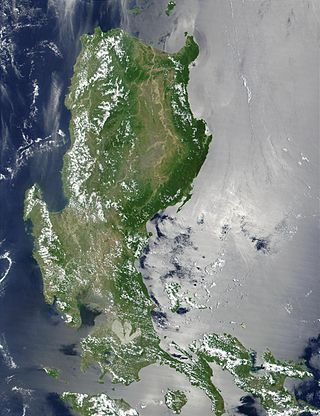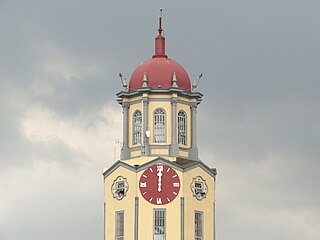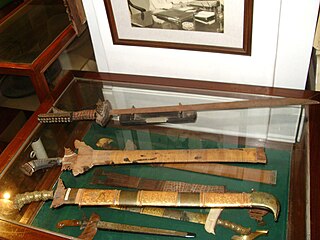
Miguel López de Legazpi, also known as El Adelantado and El Viejo, was a Spanish conquistador who financed and led an expedition to conquer the Philippine islands in the mid-16th century. He was joined by Guido de Lavezares, relative Martin de Goiti, friar Andrés de Urdaneta, and his grandsons Juan and Felipe de Salcedo, in the expedition. Legazpi established the first Spanish settlement in the East Indies after his expedition crossed the Pacific Ocean, arriving in Cebu in 1565. He became the first Governor-General of the Spanish East Indies, which was administered from New Spain for the Spanish crown. It also encompassed other Pacific islands, namely Guam, the Mariana Islands, Palau, and the Carolinas. After obtaining peace with various indigenous tribes and kingdoms, he made Cebu City the capital of the Spanish East Indies in 1565 and later transferred to Manila in 1571. The capital city of the province of Albay bears his name.

Juan de Salcedo was a Spanish conquistador. He was the grandson of Spanish general Miguel López de Legazpi. Salcedo was one of the soldiers who accompanied the Spanish conquest to the Philippines in 1565. He joined the Spanish military in 1564 at age 15, on their voyage of exploration to the East Indies and the Pacific, in search of rich resources such as gold and spice, and to find a passage to the islands were the previous Spanish expeditions led by Ferdinand Magellan had landed in 1521, and Ruy López de Villalobos in 1543.

Sulayman, sometimes referred to as Sulayman III, was a Crown Prince of the Kingdom of Luzon in the 16th century and was a nephew of King Ache of Luzon. He was the commander of Luzonian forces in the battle of Manila of 1570 against Spanish forces.
Lakandula was the title of the last lakan or paramount ruler of pre-colonial Tondo when the Spaniards first conquered the lands of the Pasig River delta in the Philippines in the 1570s.
Martín de Goiti was a Spanish conquistador and one of the soldiers who accompanied the Spanish voyage of exploration to the East Indies and the Pacific in 1565, in search of rich resources such as gold, spice and settlements. They were seeking to find a route to the islands were the previous Spanish expeditions led by Ferdinand Magellan had landed in 1521, and Ruy López de Villalobos in 1543.

In early Philippine history, the Tagalog settlement at Tondo, sometimes referred to as the Kingdom of Tondo, was a major trade hub located on the northern part of the Pasig River delta, on Luzon island. Together with Maynila, the polity (bayan) that was also situated on the southern part of the Pasig River delta, had established a shared monopoly on the trade of Chinese goods throughout the rest of the Philippine archipelago, making it an established force in trade throughout Southeast Asia and East Asia.

The Battle of Bangkusay, on June 3, 1571, was a naval engagement that marked the last resistance by locals to the Spanish Empire's occupation and colonization of the Pasig River delta, which had been the site of the indigenous polities of Rajahnate of Maynila and Tondo.

Luzones was a demonym used by Portuguese sailors in Malaysia during the early 1500s, referring to the Kapampangan and Tagalog people who lived in Manila Bay, which was then called Lusong. The term was also used for Tagalog settlers in Southern Tagalog region, where they created intensive contact with the Kapampangans.

Akí, also known as Rája Matandâ, was King of Luzon who ruled from the kingdom's capital Manila, now the capital of the Republic of the Philippines.

Tarik Sulayman, also spelled Tarik Soliman, is the most popular of several names attributed by Kapampangan historians to the individual that led the forces of Macabebe against the Spanish forces of Miguel López de Legazpi during the Battle of Bangkusay Channel on June 3, 1571. Aside from "Tarik Sulayman", this individual has also been associated with the names Bambalito or Bankau by some historians, while others simply consider him "nameless."

In Philippine history, the Tagalog bayan of Maynila was one of the most cosmopolitan of the early historic settlements on the Philippine archipelago. Fortified with a wooden palisade which was appropriate for the predominant battle tactics of its time, it lay on the southern part of the Pasig River delta, where the district of Intramuros in Manila currently stands, and across the river from the separately-led Tondo polity.

The earliest recorded history of Manila, the capital of the Philippines, dates back to the year 900 AD as recorded in the Laguna Copperplate Inscription. By the thirteenth century, the city consisted of a fortified settlement and trading quarter near the mouth of the Pasig River, the river that bisects the city into north and south.
Panday Pira was a Filipino kapampángan blacksmith His name literally translates as "Blacksmith Pira", panday being the Tagalog word for "blacksmith".
Datu Magat Salamat was a Filipino historical figure best known for co-organizing the Tondo Conspiracy of 1587. He was one of at least four sons of Lakandula, and thus held the title of Datu under his cousin and co-conspirator Agustin de Legazpi, who had been proclaimed paramount ruler of the indianized kingdom of Tondo after the death of Lakandula, although the position soon became little more than a courtesy title.
In Philippine folk tradition, Rajah Salalila was the Rajah or paramount ruler of the early Indianized Philippine settlement of Maynila, and the father of the individual named Ache, who would eventually be well known as Rajah Matanda. Based on perceived similarities between the names, he is sometimes also called Sulaiman I in the belief that he shared the name of his supposed grandson, Rajah Sulayman.

Warfare in pre-colonial Philippines refers to the military history of the Philippines prior to Spanish colonization.

In early Philippine history, the Tagalog bayan of Cainta was a fortified upriver polity that occupied both shores of an arm of the Pasig River. It was located not far from where the Pasig River meets the Lake of Ba-i and is presumed to be the present site of the municipality of Cainta, Rizal.
Agustin de Legazpi is a prominent historical figure in the Philippines best known as the leader of the Tondo Conspiracy of 1587–1588, the last native ruler of Tondo, and the last individual to hold the title of paramount ruler in any of the Indianized indigenous Tagalog polities of the Pasig River delta, although it had been reduced to little more than a courtesy title by the time of Agustin de Legazpi's execution. He was a great grandson of the Bruneian Sultan and distant descendant of Caliph Hasan ibn Ali and was a convert from Islam to Christianity, his Bruneian name was Rajah Muhammad Zahir al-Din.
The term "Lakan Dula Documents" is used by Philippine historiographers to describe the section of the Spanish Archives in Manila which are dedicated to the genealogical records of the "Manila aristocracy" from the period immediately following European colonial contact. As of 2001, only one bundle of twelve folders remains in the archive, the rest having been lost, misplaced, or destroyed by various events such as the Japanese Occupation of Manila during World War II. The surviving bundle is labeled "Decendientes de Don Carlos Lacandola", and scholars use the term "Lacandola Documents" as an informal shortcut.
Kandarapa was a native Filipina princess of the Kingdom of Tondo in the island of Luzon during the 16th century Spanish conquest of the Philippines, and the wife of the Spanish conquistador Juan de Salcedo. She was described as a beautiful young woman who came from a tribal royal family. Kandarapa was the niece of Rajah Lakandula, the king of Tondo, and the daughter of Bunao Lakandula's sister, Princess Salanta, who became a widow at a young age. She was named after the native Filipino Kandarapa bird, a lark that frequently stayed amongst the rice padies, whose songs she imitated with her beautiful voice. Her uncle, the king, resisted conversion to Islam and remained to his native Filipino (Hindu-Malay) religion of his forebears and although Tondo was an older kingdom, it ceded power to Manila which was established as a satellite state subservient to the Sultanate of Brunei after a Bruneian settlement of Luzon. Islam was brought to the islands by preachers that had travelled from the islands of Borneo and Indonesia. During this period, Islam had slowly began converting the native tribes of Luzon. Lakandula, desirous of forging an alliance with the much more powerful Rajah of Macabebe, Tariq Sulayman, betrothed her niece to the Rajah of Macabebe, an arrangement Princess Kandarapa disapproved because he already had multiple wives from previous marriages as a result of his Islamic tradition. Had the Spaniards arrived a century later, the Philippines would have been an Islamic country.













